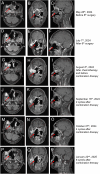Efficacy of toripalimab in combination with anlotinib in recurrent undifferentiated pleomorphic sarcoma of the sinonasal region: a case report with biomarker analysis
- PMID: 40416963
- PMCID: PMC12098334
- DOI: 10.3389/fimmu.2025.1541209
Efficacy of toripalimab in combination with anlotinib in recurrent undifferentiated pleomorphic sarcoma of the sinonasal region: a case report with biomarker analysis
Abstract
Background: Soft tissue sarcoma (STS) typically originates in the muscles and is associated with a poor prognosis. Undifferentiated pleomorphic sarcoma (UPS) is the most commonly diagnosed subtype of STS; however, UPS occurring in the sinonasal region is exceedingly rare and lacks effective treatment options.
Objective: This case report presents a patient with sinonasal UPS who experienced disease progression after surgery and chemotherapy but showed a positive response to combination therapy with toripalimab and anlotinib. Additionally, it explores the underlying biomarkers associated with this case.
Case: A 63-year-old woman with no significant past medical history was diagnosed with sinonasal UPS. The lesions recurred despite seven extensive surgical resections, and standard chemotherapy failed to control the disease, leading to progressive disease (PD).
Results: The patient was treated with a combination of toripalimab and anlotinib, resulting in a significant partial response (PR) after just two cycles. Continued PR was observed after an additional six cycles, indicating the potential for a prolonged response with ongoing therapy. Genotyping and immunohistochemistry revealed that the sarcoma cells were rapidly dividing and enriched in vasculature prior to systemic treatment.
Conclusion: These findings suggest that the combination of toripalimab and anlotinib may be an effective treatment option for advanced cases of UPS in the sinonasal region.
Keywords: anlotinib; case report; recurrence; toripalimab; undifferentiated pleomorphic sarcoma.
Copyright © 2025 Wu, Feng, Wang, Wang, Cui, Liu, Yan, Ye, Thorne, Zhang and La.
Conflict of interest statement
The authors declare that the research was conducted in the absence of any commercial or financial relationships that could be construed as a potential conflict of interest.
Figures




Similar articles
-
Case Report: Two Cases of Soft-Tissue Sarcomas: High TMB as a Potential Predictive Biomarker for Anlotinib Combined With Toripalimab Therapy.Front Immunol. 2022 May 6;13:832593. doi: 10.3389/fimmu.2022.832593. eCollection 2022. Front Immunol. 2022. PMID: 35603147 Free PMC article.
-
Combination of anlotinib and toripalimab for an advanced biliary tract cancer patient with high Eastern Cooperative Oncology Group performance status: a case report.Anticancer Drugs. 2024 Sep 1;35(8):752-756. doi: 10.1097/CAD.0000000000001619. Epub 2024 May 10. Anticancer Drugs. 2024. PMID: 38728054 Free PMC article.
-
Case report: Sintilimab combined with anlotinib as neoadjuvant chemotherapy for metastatic bone tumor resection in patients with PSC.Front Immunol. 2024 May 2;15:1372279. doi: 10.3389/fimmu.2024.1372279. eCollection 2024. Front Immunol. 2024. PMID: 38756778 Free PMC article.
-
Rapid Response to Penpulimab Combined With Anlotinib and Chemotherapy in a Thoracic SMARCA4-UT Without PD-L1 Expression: A Case Report and Review of Literature.Clin Respir J. 2024 Dec;18(12):e70036. doi: 10.1111/crj.70036. Clin Respir J. 2024. PMID: 39648153 Free PMC article. Review.
-
Treatment of Retroperitoneal Well-Differentiated Liposarcoma with Combination of Penpulimab and Anlotinib: A Case Report and Literature Review.Niger J Clin Pract. 2025 Jan 1;28(1):128-133. doi: 10.4103/njcp.njcp_817_23. Epub 2025 Mar 17. Niger J Clin Pract. 2025. PMID: 40326946 Review.
References
Publication types
MeSH terms
Substances
LinkOut - more resources
Full Text Sources
Medical
Research Materials
Miscellaneous

